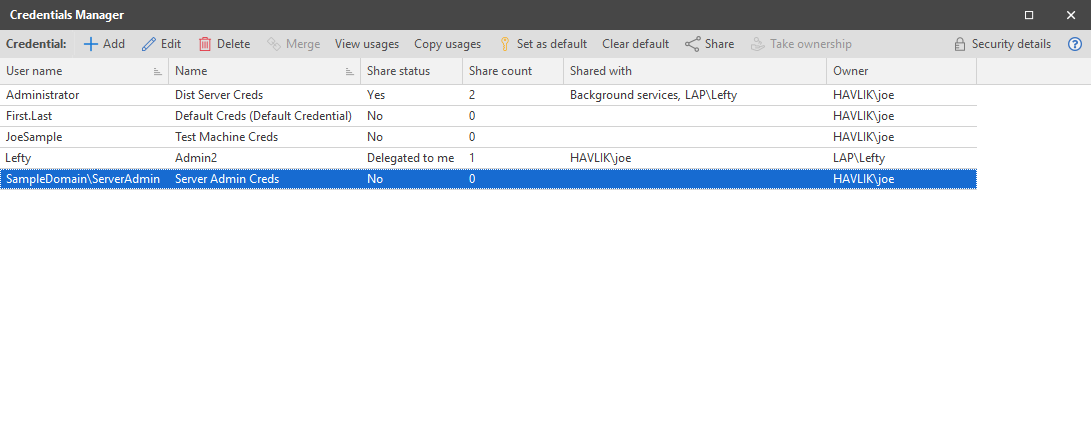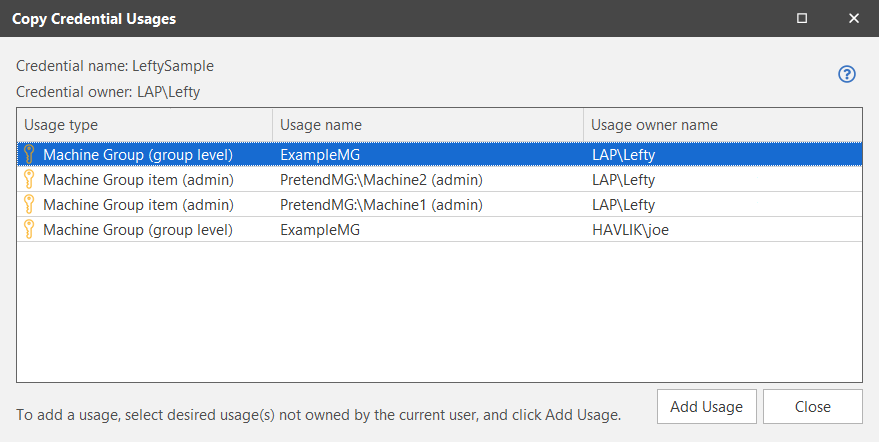Managing Credentials
IMPORTANT! If there are two or more administrators using Security Controls, you will likely want to use shared credentials. If you choose not to use shared credentials, each administrator will need to provide their own machine credentials. For details, see Potential Issues When Using Multiple Admins.
The Credentials Manager is used to manage all credentials used within the program. It is also used to set the default credential for the program.
Although you can supply new credentials from several different areas of the program, all of the credentials can be edited and deleted from this single location. This greatly simplifies the credentials management process. For example, if a password that is used to authenticate a specific group of machines changes, you simply use the Credentials Manager to update the associated credential. All items assigned to that credential are automatically updated with the new password.
To manage the credentials used by the program, select Manage > Credentials.
|
Field |
Description |
|---|---|
|
Add |
Enables you to add a new credential. See Defining Credentials for details. |
|
Edit |
Enables you to modify the selected credential. See Defining Credentials for details. |
|
Delete |
Deletes the selected credential. You can delete multiple credentials at the same time. When you delete a credential the following occurs:
CAUTION! Any items using the deleted credential will no longer be assigned a credential. Before you delete a credential, you should use the View usages button to verify the credential is not being used. |
|
Merge |
Enables you to merge two or more credentials that contain the same user name and password. Or, you can merge several different credentials into one new credential that is effective in all situations. By eliminating duplicate and unneeded credentials, you reduce confusion and lessen the chance for human error. The resulting credential will automatically be applied to every area of the program that currently uses any of the credentials that are being merged (see View usages).
For security purposes, the resulting credential will not be shared with other users even if the merged credentials were being shared. If you want to share the new credential, see Shared Credentials. |
|
Enables you to see how and where the selected credentials are being used in the program. Only those credentials that are currently being used in the program will be displayed in the Credential Usages dialog. A credential may be listed multiple times if it is used in different areas of the program. Assign different credential: Enables you to assign a different credential to the selected item(s). You can assign a different credential to multiple items at once but only if they all have the same Shared Usage value (Yes or No). Copy usage: Enables you to propagate to your user account any usage that is owned by another user. You can also right-click on any list item and perform a number of additional actions.
|
|
|
Copy usages |
Enables you to see where a shared credential is being used within the program, and by whom. You can then add any usage that is not already being used by your user account. You might do this if the credential owner, or another user who is sharing this credential, has added one or more new usages and you want to keep in sync with those users. You might also do this if usages were never copied to you when the credential owner initially shared the credentials with you. Select the usages that you want and then click Add Usage. When you are finished, click Close. You can verify the usage assignments using the View usages button. |
|
Set as default |
Assigns the selected credential as the default credential. The program will use the default credential if other credentials are missing or invalid. See Credential Precedence for information on when the default credential is used. |
|
Clear default |
Removes the default credential assignment. |
|
Share |
Enables you to share the selected credential with other users and with background services. It also enables you to modify existing shared settings. This button is only available if you are the owner of the credential. |
|
Take ownership |
Allows you to assume control of a credential that is being shared with you and/or background services. You might do this if you need to make changes to the credential and the original owner is not available to make the changes. |
|
Security details |
See Potential Security Implications When Sharing Credentials. |
|
User name |
Displays the user name portion of each credential. |
|
Name |
Displays the unique name assigned to each credential. |
|
Share status |
Displays whether the credentials are shared credentials. Possible values are:
|
|
Share count |
Displays the number of users with whom the credential is shared. If the credential is shared with background services, that counts as one user. |
|
Shared with |
Displays the names of the users who have the ability to use this credential. If this credential is also shared with background tasks, the term Background services will be displayed. |
|
Owner |
Displays the name of the user who owns the credential. Only an owner can modify or share a specific credential. |



